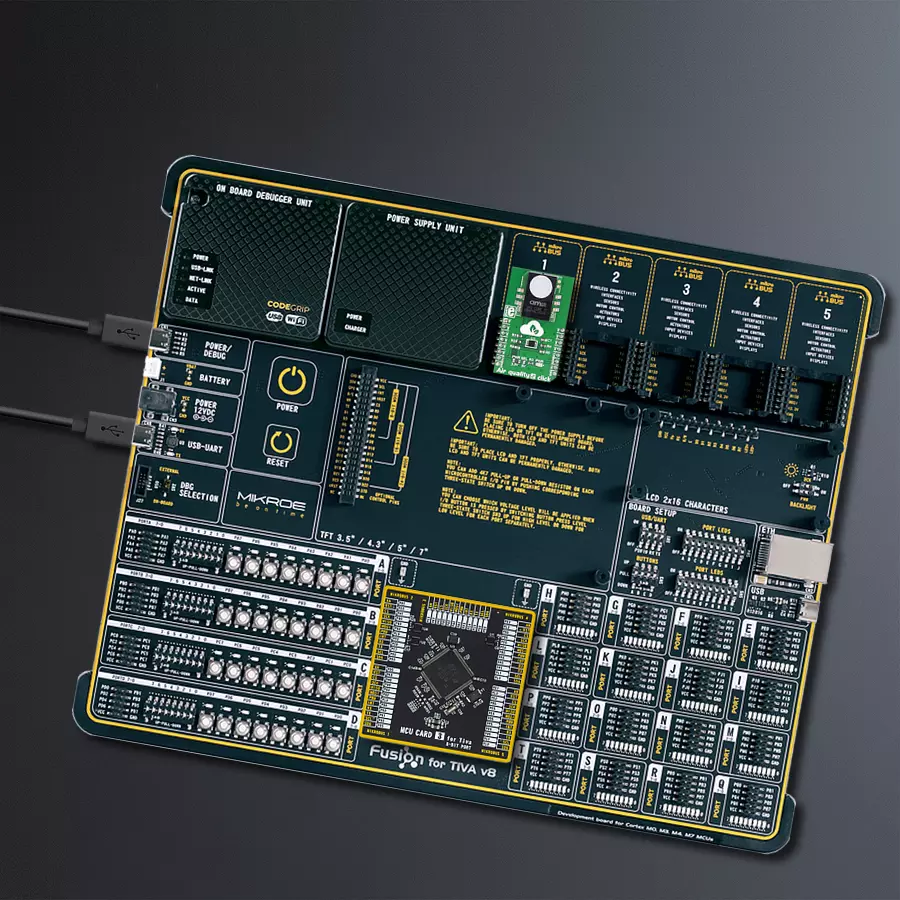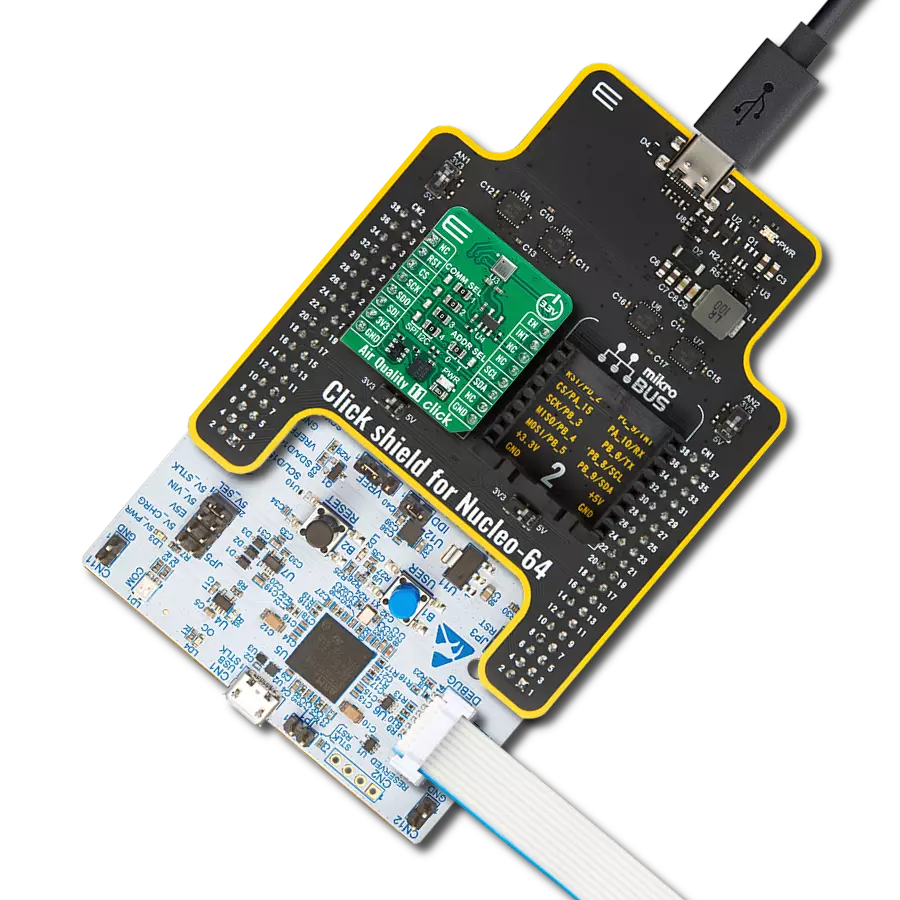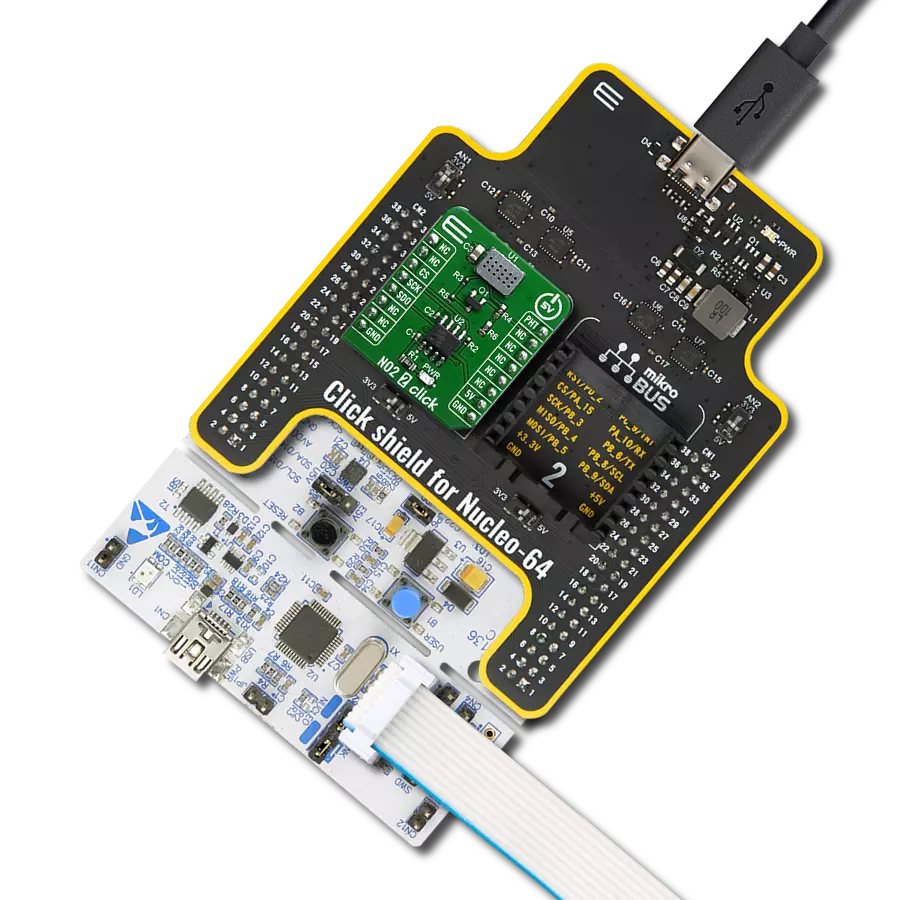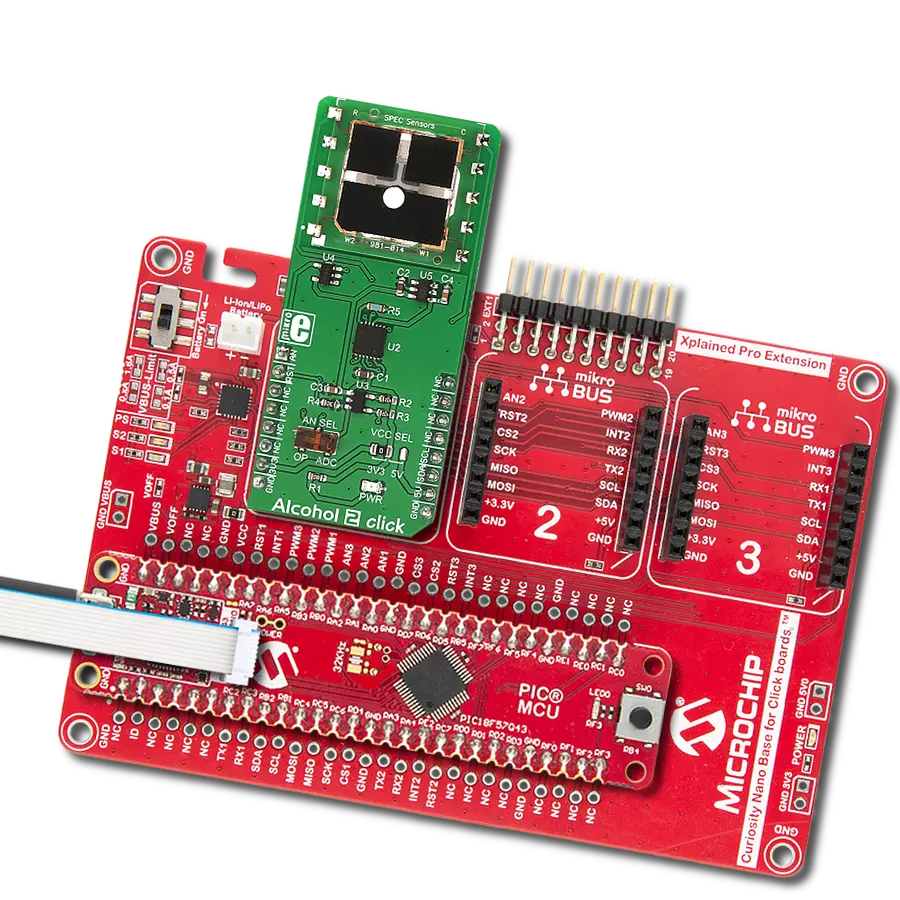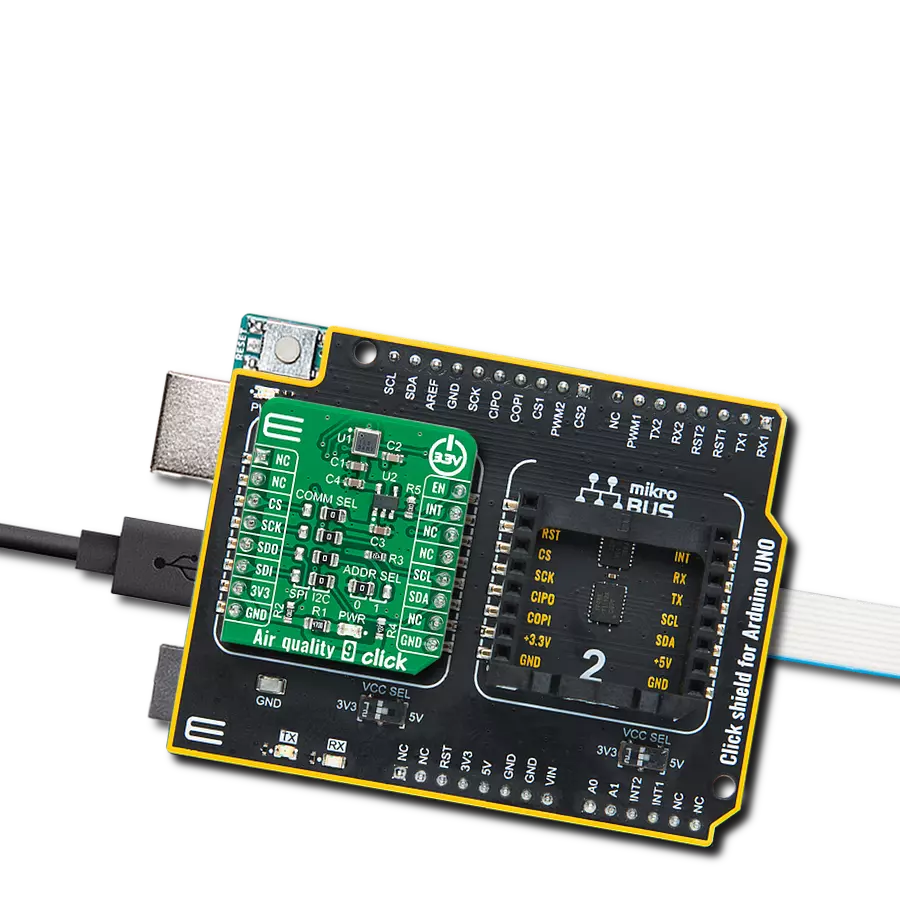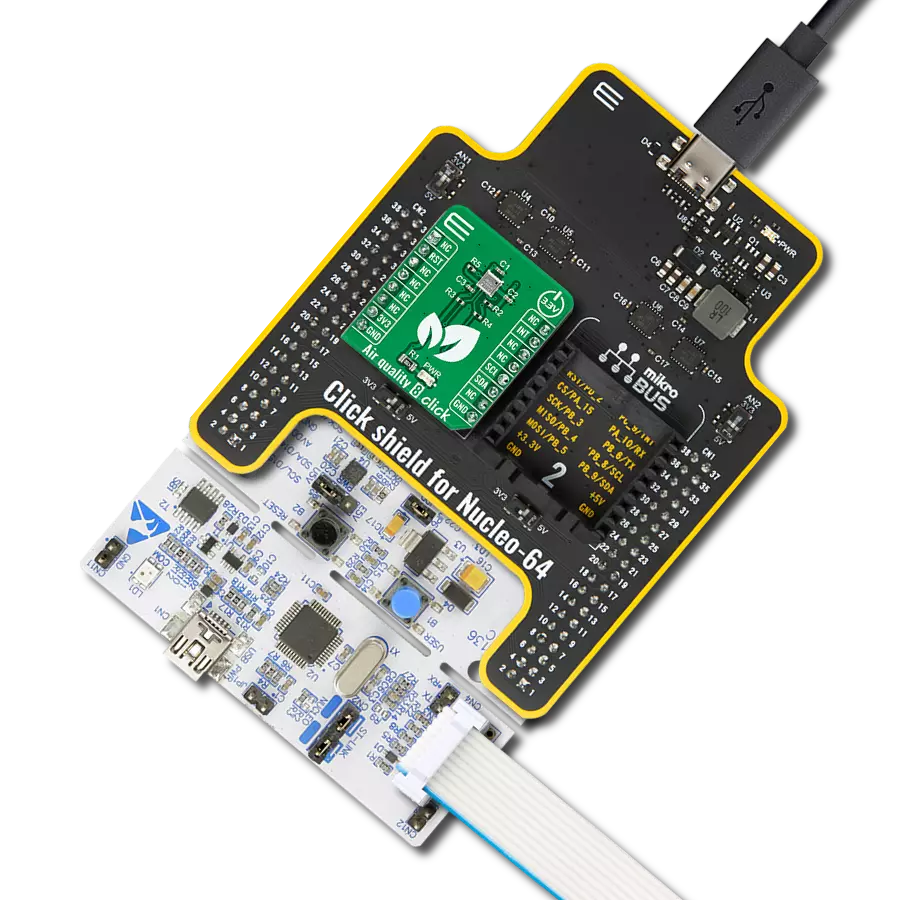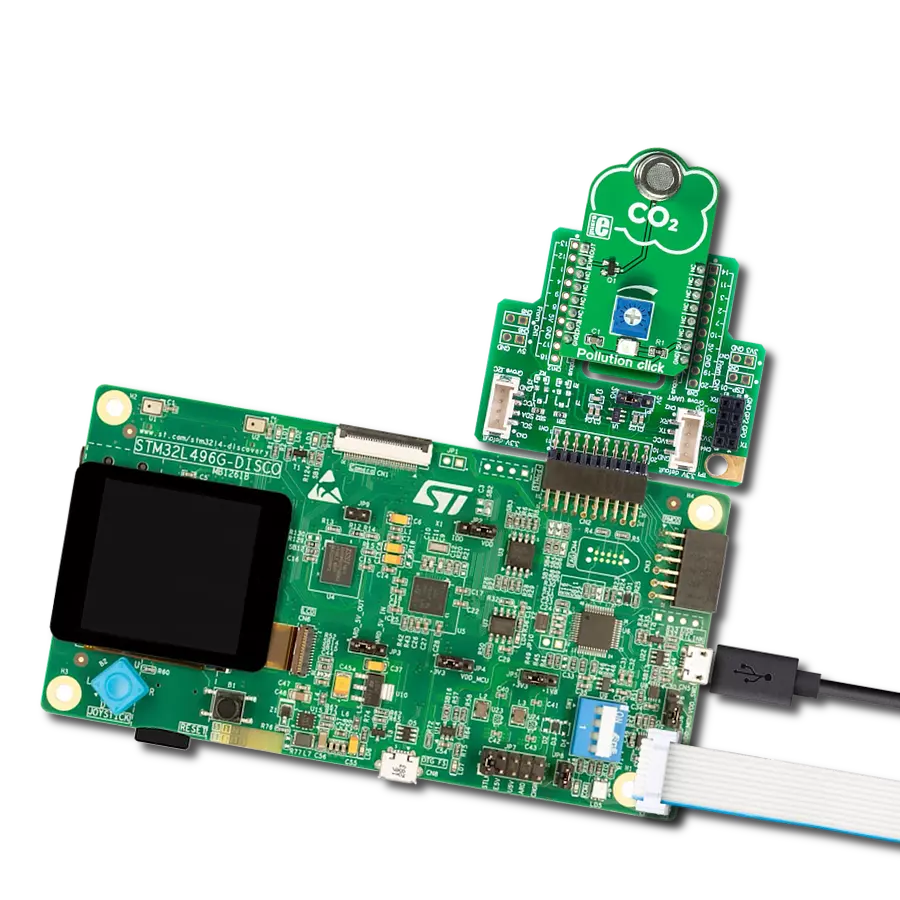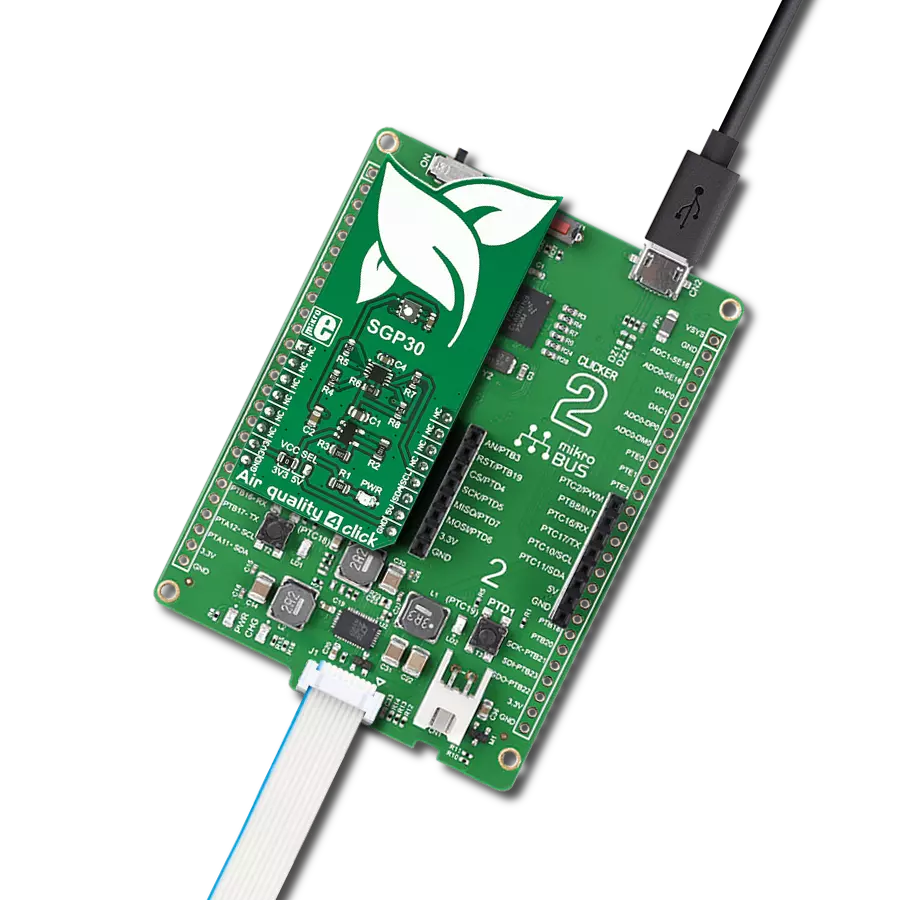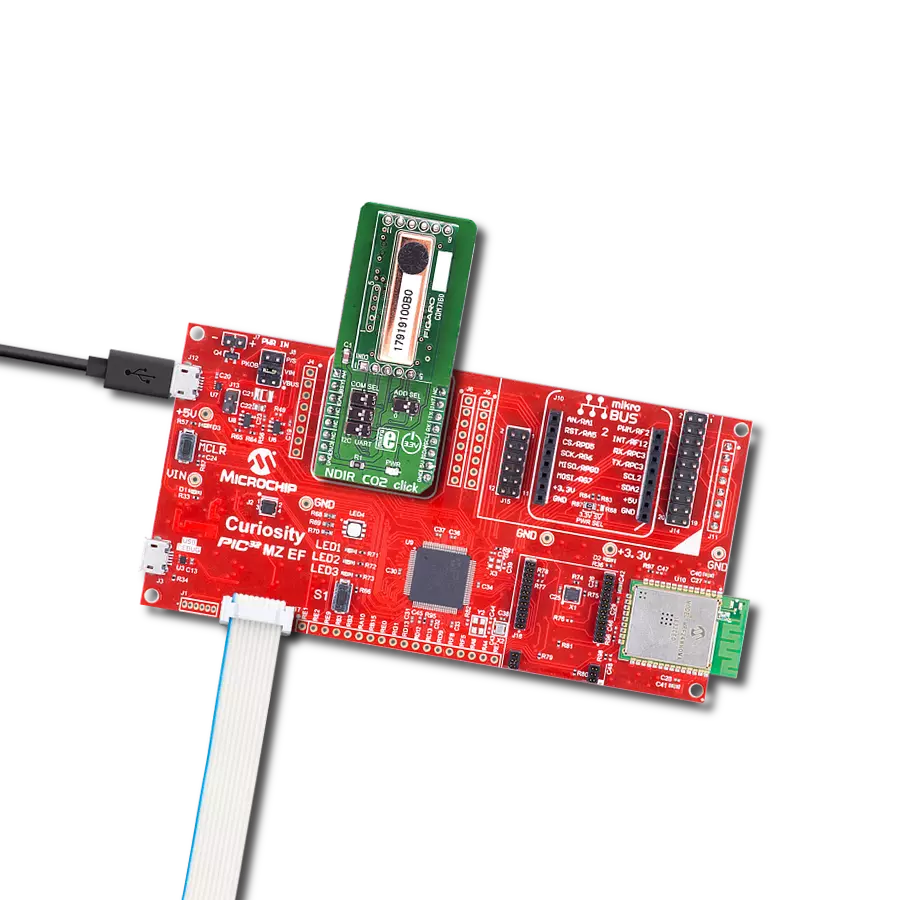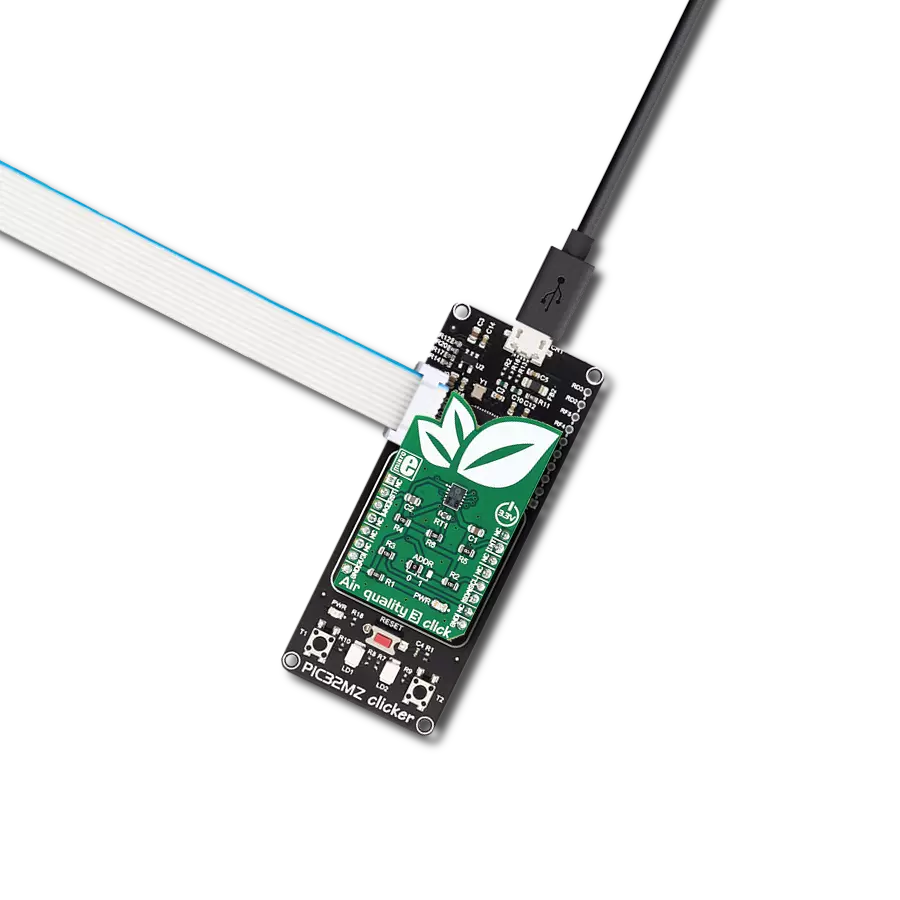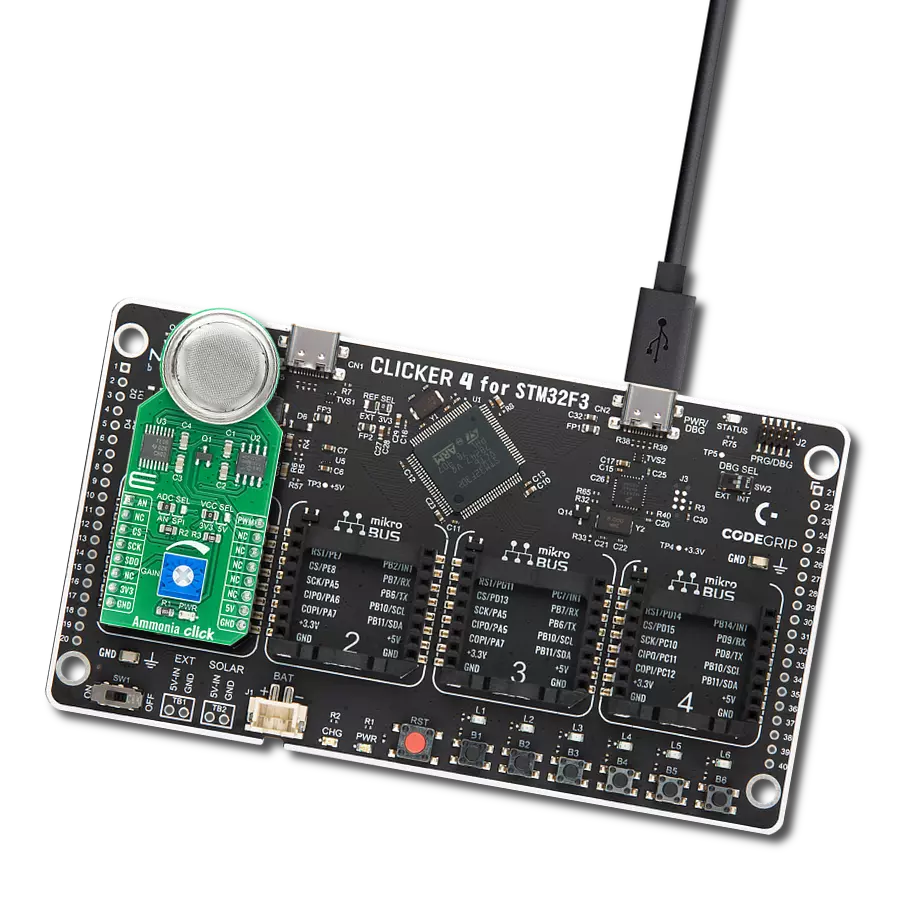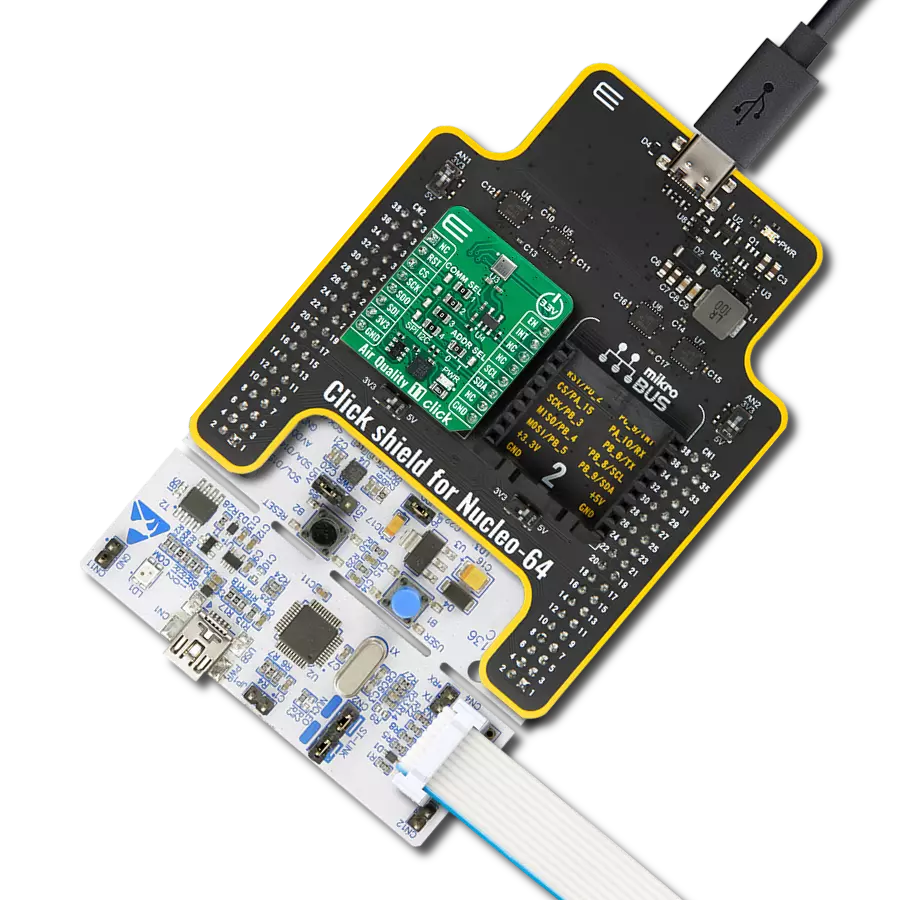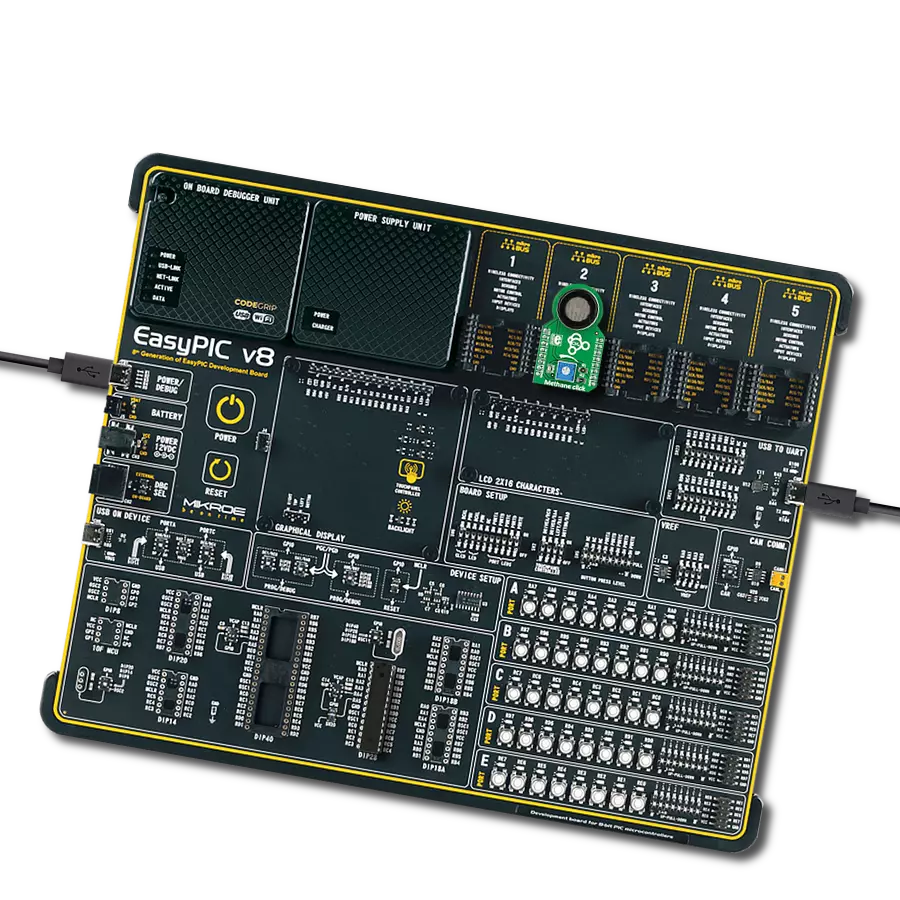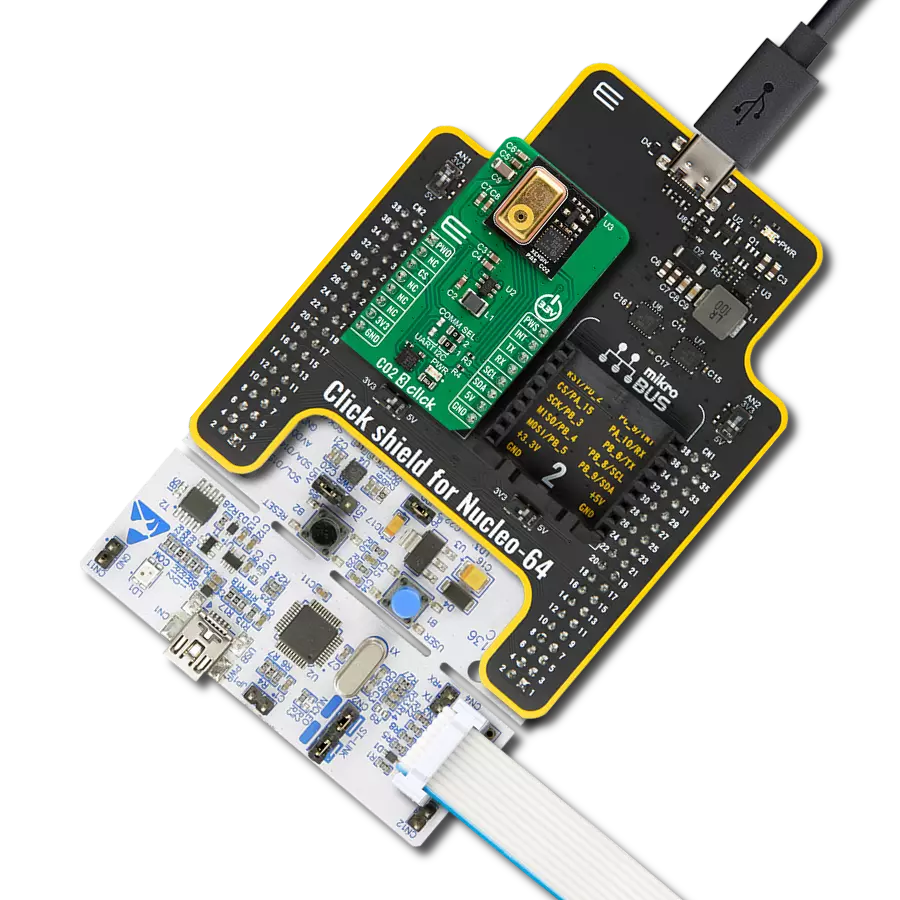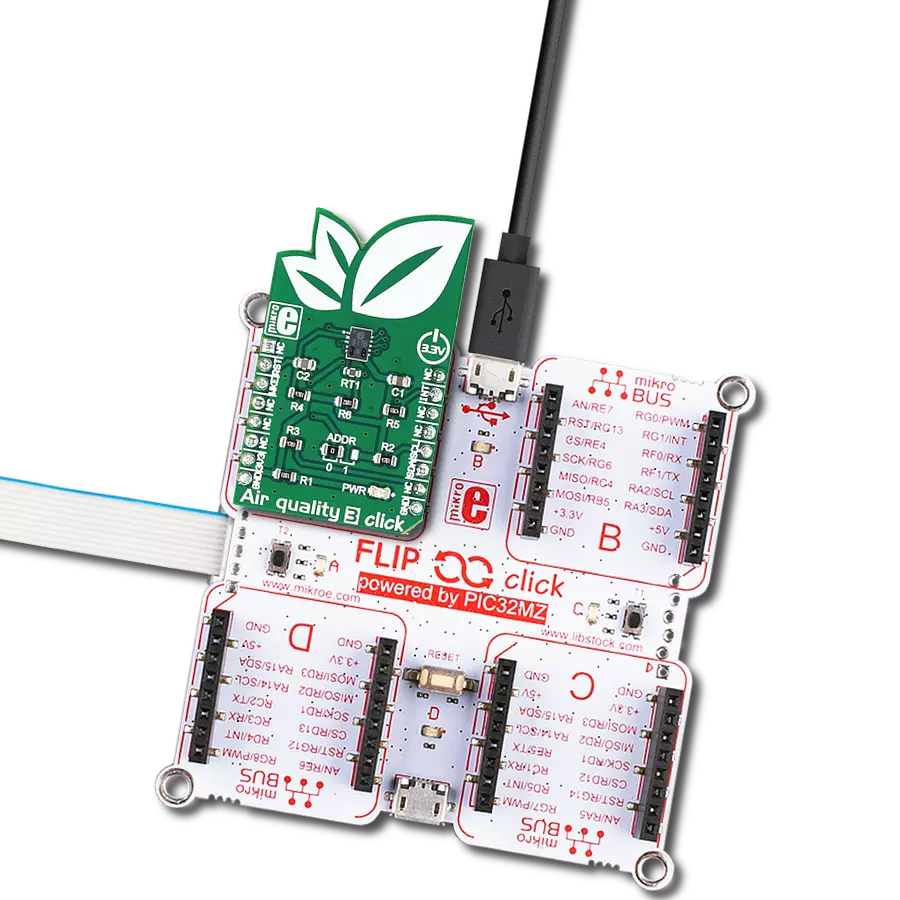Join the movement for healthier air with our advanced air quality technology
A
A
Hardware Overview
How does it work?
Air Quality 2 Click is based on the iAQ-Core Indoor Air Quality sensor from ScioSense that measures VOC (volatile organic compounds) levels and provides CO2 equivalent and TVOC (total volatile organic compounds) equivalent predictions. The click is designed to run on either a 3.3V or 5V power supply. It communicates with the target MCU over I2C. A plastic cap and a filter membrane protect the sensor. This membrane should not be removed or touched. The sensing range for CO2 equivalents is 450 to 2000 ppm (parts per million) and from 125 to 600 ppb (parts per billion) for TVOC equivalents. The first functional reading takes only 5 minutes after start-up time. After the sensor is powered on, you don't have to wait for it
to calibrate. You'll have all the readings you need in less time than it takes to make a cup of coffee. iAQ-Core sensor has Automatic Baseline Correction (ABC), which means that you don't need to make any further calibration. You can use it for many years in a normal indoor environment. With low power consumption (maximum of 9mW in pulsed mode and 66mW in continuous mode), Air Quality 2 Click is ideal for Smart Home applications and IoT projects and devices that require long battery life. Volatile organic compounds, or VOCs, are organic chemicals. They have very high vapor pressure at room temperature, and some can harm human health. These chemicals are carbon-based (formaldehyde,
toluene, benzene, and more) and are called "volatile" because they become gases at room temperature. They are emitted from various products, like hairspray, household cleaning products, paint, or air freshener, that we use daily. This Click board™ can operate with either 3.3V or 5V logic voltage levels selected via the PWR SEL jumper. This way, both 3.3V and 5V capable MCUs can use the communication lines properly. Also, this Click board™ comes equipped with a library containing easy-to-use functions and an example code that can be used as a reference for further development.
Features overview
Development board
Fusion for TIVA v8 is a development board specially designed for the needs of rapid development of embedded applications. It supports a wide range of microcontrollers, such as different 32-bit ARM® Cortex®-M based MCUs from Texas Instruments, regardless of their number of pins, and a broad set of unique functions, such as the first-ever embedded debugger/programmer over a WiFi network. The development board is well organized and designed so that the end-user has all the necessary elements, such as switches, buttons, indicators, connectors, and others, in one place. Thanks to innovative manufacturing technology, Fusion for TIVA v8 provides a fluid and immersive working experience, allowing access
anywhere and under any circumstances at any time. Each part of the Fusion for TIVA v8 development board contains the components necessary for the most efficient operation of the same board. An advanced integrated CODEGRIP programmer/debugger module offers many valuable programming/debugging options, including support for JTAG, SWD, and SWO Trace (Single Wire Output)), and seamless integration with the Mikroe software environment. Besides, it also includes a clean and regulated power supply module for the development board. It can use a wide range of external power sources, including a battery, an external 12V power supply, and a power source via the USB Type-C (USB-C) connector.
Communication options such as USB-UART, USB HOST/DEVICE, CAN (on the MCU card, if supported), and Ethernet is also included. In addition, it also has the well-established mikroBUS™ standard, a standardized socket for the MCU card (SiBRAIN standard), and two display options for the TFT board line of products and character-based LCD. Fusion for TIVA v8 is an integral part of the Mikroe ecosystem for rapid development. Natively supported by Mikroe software tools, it covers many aspects of prototyping and development thanks to a considerable number of different Click boards™ (over a thousand boards), the number of which is growing every day.
Microcontroller Overview
MCU Card / MCU
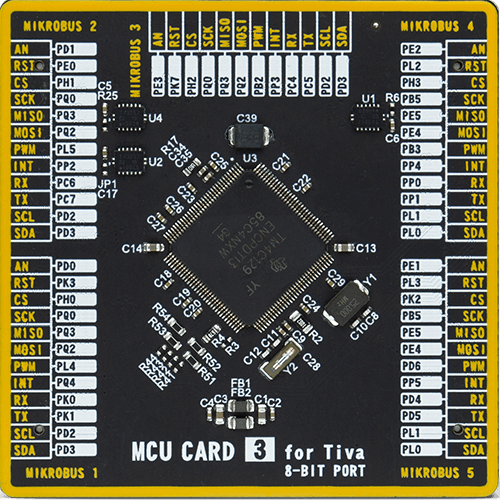
Type
8th Generation
Architecture
ARM Cortex-M4
MCU Memory (KB)
512
Silicon Vendor
Texas Instruments
Pin count
128
RAM (Bytes)
262144
Used MCU Pins
mikroBUS™ mapper
Take a closer look
Click board™ Schematic

Step by step
Project assembly
Software Support
Library Description
This library contains API for Air Quality 2 Click driver.
Key functions:
airquality2_generic_read- This function reads dataairquality2_get_all_data- Reads all data information about the indoor air quality
Open Source
Code example
The complete application code and a ready-to-use project are available through the NECTO Studio Package Manager for direct installation in the NECTO Studio. The application code can also be found on the MIKROE GitHub account.
/*!
* \file
* \brief Airquality2 Click example
*
* # Description
* This app measure indoor air quality.
*
* The demo application is composed of two sections :
*
* ## Application Init
* Initialization device.
*
* ## Application Task
* This is a example which demonstrates the use of Air quality 2 Click board.
* Read all data information about the indoor air quality
* from register on the iAQ-Core module, display Prediction Value CO2 [ ppm ],
* Prediction Value TVOC [ ppb ] and Resistance Value.
* Results are being sent to the Usart Terminal where you can track their changes.
* All data logs on usb uart for aproximetly every 5 sec.
*
* ## NOTE
* The sensor is in warm-up phase when the status is RUNIN. The user should wait
* for status OK in order to get valid data output.
*
* \author MikroE Team
*
*/
// ------------------------------------------------------------------- INCLUDES
#include "board.h"
#include "log.h"
#include "airquality2.h"
// ------------------------------------------------------------------ VARIABLES
static airquality2_t airquality2;
static log_t logger;
// ------------------------------------------------------ APPLICATION FUNCTIONS
void application_init ( void )
{
log_cfg_t log_cfg;
airquality2_cfg_t cfg;
/**
* Logger initialization.
* Default baud rate: 115200
* Default log level: LOG_LEVEL_DEBUG
* @note If USB_UART_RX and USB_UART_TX
* are defined as HAL_PIN_NC, you will
* need to define them manually for log to work.
* See @b LOG_MAP_USB_UART macro definition for detailed explanation.
*/
LOG_MAP_USB_UART( log_cfg );
log_init( &logger, &log_cfg );
log_info( &logger, "---- Application Init ----" );
// Click initialization.
airquality2_cfg_setup( &cfg );
AIRQUALITY2_MAP_MIKROBUS( cfg, MIKROBUS_1 );
airquality2_init( &airquality2, &cfg );
// Click calibration
uint8_t dummy_buffer[ 9 ];
airquality2_generic_read( &airquality2, dummy_buffer, AIRQUALITY2_READ_ALL );
log_printf( &logger, "----------------------------------\r\n" );
log_printf( &logger, " Air quality 2 \r\n" );
log_printf( &logger, "----------------------------------\r\n" );
Delay_ms ( 100 );
}
void application_task ( void )
{
uint8_t status_info;
uint16_t value_co2;
uint16_t value_tvoc;
int32_t resistance;
status_info = airquality2_get_all_data( &airquality2, &value_co2, &value_tvoc, &resistance );
Delay_100ms( );
if ( status_info == AIRQUALITY2_STATUS_OK )
{
log_printf( &logger, " | Status : OK |\r\n" );
}
if ( status_info == AIRQUALITY2_STATUS_BUSY )
{
log_printf( &logger, " | Status : BUSY |\r\n" );
}
if ( status_info == AIRQUALITY2_STATUS_ERROR )
{
log_printf( &logger, " | Status : ERROR |\r\n" );
}
if ( status_info == AIRQUALITY2_STATUS_RUNIN )
{
log_printf( &logger, " | Status : RUNIN |\r\n" );
}
log_printf( &logger, "----------------------------------\r\n" );
log_printf( &logger, " CO2 : %u [ ppm ] \r\n", value_co2 );
log_printf( &logger, " TVOC : %u [ ppb ] \r\n", value_tvoc );
log_printf( &logger, " Resistance : %ld [ Ohm ] \r\n", resistance );
log_printf( &logger, "----------------------------------\r\n" );
Delay_1sec( );
Delay_1sec( );
Delay_1sec( );
Delay_1sec( );
Delay_1sec( );
}
int main ( void )
{
/* Do not remove this line or clock might not be set correctly. */
#ifdef PREINIT_SUPPORTED
preinit();
#endif
application_init( );
for ( ; ; )
{
application_task( );
}
return 0;
}
// ------------------------------------------------------------------------ END
Additional Support
Resources
Category:Gas






